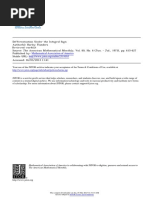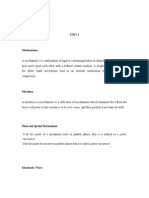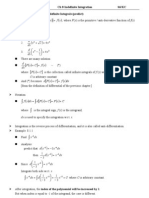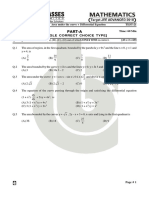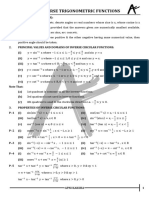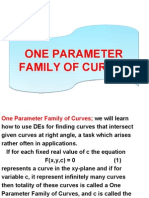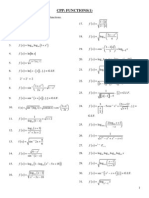0 ratings0% found this document useful (0 votes)
99 viewsCalculus Reduction Formulas
calculas reduction furmula
Uploaded by
Vikram SinghCopyright
© © All Rights Reserved
Available Formats
Download as PDF or read online on Scribd
0 ratings0% found this document useful (0 votes)
99 viewsCalculus Reduction Formulas
calculas reduction furmula
Uploaded by
Vikram SinghCopyright
© © All Rights Reserved
Available Formats
Download as PDF or read online on Scribd
You are on page 1/ 20
SS
6
Reduction Formulas
ge mee ete ee Re eee
[EARNING OBJECTIVES
ter studying the material in this chapter, you should be able to :
+ Integrate positive integer powers of sine and cosine using reduction formulas.
+ Braluate integrals of the form [sin™ xcos" xdx, where m and n are positive integers.
+ Evaluate integrals of the form sin maxcosnx dx, [sin mx sin nxdr,and Joosmxcosnedr.
+ Integrate positive integer powers of tangent and secant using reduction formulas.
+ Evaluate integrals of the form | tan" xsec" xdx, where m and n are positive integers.
«+ Iitegrate positive integer powers of cotangent and cosecant using reduction formulas.
6.1 INTRODUCTION TO REDUCTION FORMULAS
reduction formula is a formula that expresses an integral involving a power of a function in
lerms of another integral that involves a smaller power of that function such that the repeated
application of the formula enables us to evaluate the given integral. Reduction formulas are useful
for integrating positive integer powers of sine, cosine, and other kinds of integrals that involve
‘vigonometric functions. Reduction formulas can be obtained using integration by parts technique.
52. INTEGRATING POWERS OF SINE AND COSINE
|htis section we will derive reduction formulas for integrating positive integer powers of sine and
‘cwsine,
: 7
Pa Reduction Formula for [sin” x dx
ive the reduetion formula
2.(1)
vat!
= nlp ns
sin” xe = — S07 008% 4 Tf sint ? x de
7H 7"
here
nz ;
22is an integer. Hence evaluate fsin® x dx,
62 :
; Cty
SOLUTION We write
Joint x a = Joint x sinx de
Applying integration by parts with w= sin" ' x, we get
sin? xde = sin“! x(—cosx) = f("— I)sin"~? xcos.x(—cosx)dx
=sin"™! xeosx +(n—1)f sin"? xcos? x dx
= sin"! xeosx +(n—Df sin"? x(1-sin® x) dx
o
= -sin™ xcosx+ (n—Dfsin"™ x de—(n—1f sins a
Transposing the last term on the right side to the left side, we get
nf sin” xdx = =sin"! xeosx + (n=Df sin"? x de
Dividing by m yields
fsin® xd = “> FoM sin x ae,
which is the required reduction formula that expresses the integral Jasin" xdv in terms of te
integral [sin x dx. Thus, if this formula is applied repeatedly, the integral sin" xdx can
eventually be expressed in terms of [sin? x dx = [dv ifn is even or Jsinx de if mis odd, at which
point the integration can be completed.
To evaluate fsin®x dt, we apply the reduction formula (1) repeatedly with n= 6, "= 4 and
2:
n
sin’ xcosx | 5
_ Sin? xeosx | 5
Join’ xdx = 7 7
Jsin' x as
los 5{_ sin? xcosx 37.2
— Z| SR AEST dx
giinexcoss sin’ x
4
iE in xcos x
—| in’ xeosx—2 sin? xcosx+3| —S24°8* +
6 24 : 8 2
i” 5 5 5
=sin’ xcosx-—sin® —2 si yecexte
A 3 —Fsin’ xeos x sin.xeosx +75
ee ih he
Note If is a positive integer and 1? 2, then the integral [sin" x dx may be evaluated wil 3
help ofa reduction formula, However, it need only be applied when » is an even posit’? integet
5 ving
the case where nis odd, the integra {sin” x dx can more easily be evaluated by using th followine
procedure :
edt" Formulas :
procedure fOr evaluating [sin dx, ifn is am odd integer
ap. Split off @ factor of sin x
2, Use the, identity sin? x
we (1 — cos?) times sin x.
3, Make the substitution # = cos x to convert the integrand into a polynomial in wv.
suep 4 Integrate using the power function formula,
usirate the procedure, let us consider the following example,
- cos* i
1 = cos* x to express the integrand as a power of.
il
7 ind x de
pxAMPLE2 Evaluate [sin® x de.
SOLUTION Since n = 5 is odd, we will follow the procedure stated above,
fain’ x dx = Jain’ x sinx dx = f (sin? ay? sinxae = J(-cos?x)?sinx de
\Wenow make the substitution « = cos x, so that di = —sin.x dx.
Join’ x dk = fd) du = ~fd- 20? ude = mud? - 5 +e
2 os} x—dcost
= -cos.x+ cos? x- cos x +e
3 5
nI2 9 a
Thaluation of the definite integral ["" sin’ x dx, where > 2 is an integer
EXAMPLE 3 Prove that
_ Be if n is odd
3
LE ip niseven.
22
SOLUTION Using the reduction formula
al :
Jsin® xe = -S2 20S A sin” 2x de
7
tr Jit dc, we have
: 22 h
e/2 XCOSX Aah (alee ped, db
JP sin" x de = an fp" sin? x ae
n lo
= LP? sint? x de
0
n
Sting 1, [sin x de, we got the following formula
|
Coeaty
64
po
Fa
ith, By using this formula repeatedly, we can eventually express es
that connects J, with J, ->- BY’
of {if n is odd) or fy (if » is even).
Ty if nisodd
Ty, if nis even
Now, 7
I= f°" sinx de =|-cosx |p”? =1
Ba
2
if n is odd
if nis even.
EXAMPLE 4 Evaluate
m1 . IZ
@ f sin? x dx (b) i sin® x dx
12 7 642 16
SOLUTION (a) f sin’ x dx = 7 Scat hs
iis 75310" 35
sin'xde = 2.3.3.1 0 ane
f F642 2” 256
EXAMPLE 5 Reduction Formula for Joos" x de
Derive the reduction formula
ipo
Joost de = S087 xsing mm-1p ep (2)
n n
where n 2 2 is an integer. Hence, evaluate foostx ax,
eduction Formulas / :
quoTion Werte
feostx ae [ost x cos a
appyingimtgration by parts with v= cos"~! x, we get
Joost x dx = cos"! xsinx— f(n—I)eos"*? x(-sinx)sin x dr
atc a Bs
cos"! xsinx+(n—1)[ cos"? xsin® x dx
= cos" xsinx +(n— Dfcos" x(1-cos? x) de
= cos"! xsin x +(n—I)fcos"? x dx~(n=N)fcos"x dx
Trnsposing the last term on the right side to the left side, we get
nfcos" xdx = cos"! xsinx +(n- Df eos"? x dx
Dividing by » yields
cos"! xsinx | n-1
oe ee
Joos" xdx = *— feos xd,
7
stich is the required reduction formula that expresses the integral {cos".xdx in terms of the
inegal [cos"? x dx, Thus, if this formula is applied repeatedly, the integral Joos" xd can
eventually be expressed in terms of fos? x dx = Jae ifmiseven or Joosx de ifn is odd, at which
print the integration can be completed.
Toevaluate [cos*x dr, we apply the reduction formula (2) repeatedly with = 4 and
n=2:
Joost xdx
3 fs si
1
= fou xsinx +7 + fom a]
. 3
dogs} xsinx+2cosxsinx torte
4 8 8
N ; 0 5
te Ifn isa positive integer and n 2 2, then the integral feos’ x dx may be evaluated with the
bel ‘ nn
?ofareduction formula. However, it need only be applied when » is an even positive integer. In
the 7
“Se where n is odd, the integral Joos" x dx can more easily be evaluated by using the following
Pocedurg «
Be
6.6
Caley,
Procedure for evaluating Joos’ xdx, if m is an odd integer hy
| Step 1. Split off a factor of cos x.
Step 2. Use the identity cos? x = 1 — sin? x to express the integrand as a Power of ve
‘
times cos.x. ;
Step 3. Make the substitution v= sin x to convert the integrand into a Polynomial in y
Step 4. Integrate using the power function formula.
To illustrate the procedure, let us consider the following example.
EXAMPLE 6 Evaluate [ cos? x dx, .
SOLUTION Since n = 3 is odd, we will follow the procedure stated above,
Joos?x dr = foos? x cosx dx
= J Q-sin? x)cosx dx
= Jd-w)du, w = sinx, du =cosxde
1 7 1.
= uagw te = sinx-3sin’ xe,
12
Evaluation of the definite integral f cos” x dx, where n 2 2 is an integer
EXAMPLE 7 Prove that
2 if nis odd
i
if n is even.
I?
SOLUTION The proof of the above formula is similar to the one given for j
0
to Example 3) and left as an exercise,
Integrating Products of Sines and Cosines
and
In this section we will derive the reduction
x cos" x dx, where ™
Positive integers,
formula for [si
me ileal
poe Formulas be
4
PLE Reduetion formula for [sin x cos” x de
px
pave ouucton formula
ay = Sint cos a
atx cos" x dy = 1-2 veggt
Jain” x0 Mon ay fsin™?xeostx de (1)
sgeremand are postive integers. Hence, evaluate Jsin* x cos? x de,
soLUTION We begin by writing
fain” xe0s" x de = Jain” x(sin xcos" x) dx
Applying integration by parts with = sin"™-1 x, we obtain
na
i cant, _coshx te
[sin x cos" x de = sin! (- 7 ) -fem-Da ® xeos3
a
sin"! xcos™! x | m
geen C0e
-2 x eos" x(1—sin? x)dx
n+l nel
sn! xcost*!
sin” xcos"*!x | mol
= SE Ef sin? xc Par sn” xeos" x de
n+l ntl
Transposing the last term on the right side to the left side, we get
a1) Fm n in”! xcos™!x | m=1 2
(ieBot) fain xost a = ae alee
ntl n+l n+l
m+ an
ie, (222)faor xeos” x dr = —
xcos""!
atl n+l
ap Men
Dividing by “= yields the desired reduction formula
in! xeost!
{six cost x de = 8" noes"
m+n
+2 fsin? xoos" x de
8
1
6
? xe0s? x i sinxcos? x
6
= _ sin xoos'x_sinsoos!x | fog x de wal)
8 16 16
evalu :
ate the last integral on the right side, we use the reduction formula
Ye
68 Cater,
Dat ee crea J M2 dy
a y = —cos"”' xsinx + cos’ "x dx
Joost sate = Loos ;
repeatedly with m = 4 and n= 2. Thus,
3 3
cos* xsinx +
Joost xde Joos? x de
i
Bl Bl Ble
4
‘| af od
cos’ xsinx-+ al peo sinx + z feos? as|
3 3 . 3
cos’ xsine+ eosxsinx + ox
fae 4 :
Substituting the above expression for fos’ xdx in (2), we obtain
V3. 3
Jsin* x cos* x dx [= xsinx+ grosnas i]
8
3
inx , 3cosxsinx | 3x
8 16 64 128 ag*e
Note Notice that if we write
Jsin™ x cos" x de = Joos’! x(cosx sin” x) dv
and apply integration by parts with w = cos"~! x, we obtain an alternative form of the above
reduction formula.
ms
x
os" xsin a=
tn ee oi
Jsin” x cos" x de =
Joos”? xsin™xdr 3)
m+n men
Note Ifm and n are positive integers, then the integral Jsin” x cos" x dx may be evaluated using
the reduction formula (1) or (3). However, it need be applied only when m and 2 are both even. In
the case where ether m or n i odd (or both), the integral sn” x cos" x dt can be evalu
‘more convenientely by using the following procedure:
Procedure for evaluating
CASE 1: mis odd
Step 1.
Jin” xcos" xd, if either m oF mis odd
Split off a factor of sin
Step 2. Use the identity sin? x = 1 as art
= 1 cos? x t t the term (s
inleinsohen 'o express everything excep!
Step 3.
Make the substitution =
Step 4.
= 08 x to convert the integral into a polynomial in
Integrate using the pov
‘er function formula.
CASE 2: nis odd
This case can poe :
Pe handled in similar manner by reversing the roles of sin x.and 008 *-
6.9
pedo" Formulas
tr lustrate the procedure, let us consider the following examples,
. 8.
sane Evaluate [sin’ x cos* x dx,
TION Since m= 3 is odd, we split off'a factor of sin x and use the identity sin?
ss everything except the term (sin x dx) in terms of cos x.
sou
to expres
: 4 on? x cost
fa aPx cos’ x dx = Jain x cos! x cosx dy = Ja-cos? x)oos! xsinx dy
sabsttuting w = COS X, SO that du = —sin x dx, we obtain
sin? vcos* x de = fa=u2yut du
Jus =u) due
7 4s
W718 cost _cos*x
7 °5 e 7 5
EXAMPLE 10. Evaluate Jsin* x cos’ x dr,
SOLUTION Since n= 5 is odd, we split off factor of cos x and use the identity cos? x = 1 sin? x
tn express everything except the term (cos x dx) in terms of sin x.
sin’ x cos° x dx = Jsin® x cos* x cosx dx = Jain x(1~sin? x)? cosx ax
Substituting w= sin x, so that du = cos x dx, we obtain
Jsin’ x cos8 x dx = fut a—w?)? du
= fut —2u? +0) du
= fat —2u® +u8)du
sindx _2sin’ x
5 7 9
12m cost itive i
Evaluation of the definite integral J” sin” xcos” x dx, where m, m are positive integers.
EXAMPLE 11 If m and n are positive integers, prove that
wr
a; Sin" x cos" x dx = (mt nym n—2)
‘obe multiplied by the factor n/2 only when m and 1 are both even.
$0) fs
LUTION Using the reduction formula (1), we obtain
“<
6.10
Q
xl? ‘ley
ly gos”*!
m+n
#02 st woos" x dh + pe eine
xeos" x de sin"? y,
i mano SI" xcOs" x gy
mal er2 ge a
= =f sin™~? xcos" x dx
m+neo
BD mon
i sin™ xcos" x dx,
Setting Hiss =
we have
m
oe on
m0 men
Replacing m by m— 2; m ~ 4, and so on, we obtain
m-3
m4, 0
m+n-2
m-5
In-tan and
and finally,
Ky p= sh, » if mis odd
. 34n 5
Tag = sly, gy if miseven
2tn a
Thus,
Jane
ee demi
Now m+n mtn-2 Jag 100 if mis even
_ pez. ey
hae sin? xcos" x d= ["7c0s" x de =
if nis even
Rl= win
x
Thus, we have, n n=2n-4" 22
eet Formulas oH
m-lom3 2
er nen-2 San nar’ im isoddandn may be even orodd
m-1_m-3_ _ln-ln-3) 2
het {pan wend Den peg 3? fmisevenand nis odd
nel_m=3 lool z
een menad Den med Zp” ifmand are both even
spese formulas ca be expressed as a single formula :
x2, Dede
‘ xdx =
f sin” x cos” x dx (m+ nlm tn)
tobe multiplied by the factor x/2 only when m and n are both even. Notice that the three sets of
jecorsstating with (m— 1), (2 ~ 1), (m+n), and diminishing by 2 ata time, descend to either I
sr ovvonding as the first factor of the set is odd or even.
TXAMPLE12. Evaluate the following integrals.
12 2
to fr 'sin’x costed (a) JP sinxeost x de Gi) [sin x cos x de
5 4
SOLUTION (i) Jf) sin’ x cos* x dx =
s
315
_ (2S cosa dea 1
(i) [F sin’ x cos x de = %
a gg ge dS SR
Gin fp sin’ x 008° x d= TT G9 2 2560"
Integrals Involving Sine-Cosine Products with Different Angles
biegals ofthe form [sinmax cosnxdr, [sin mx sinnxds, Josmx cosmxds can be evaluated
by using the following trigonometric identities :
2sin A cos B = sin(d + B) + sin(4 - B)
2sin A sin B = cos(d ~ B) - cos(4 + B)
2cos A cos B = cos(4 + B) + cos(d - B)
_
SAMPLE 3. Evaluate [sinSx cosdx dt.
SSLUTION We have
i Liye :
Jsinsx cosarde = 5 Jrsinsx cos4xdx = gflcingx+sins) ae
9x cosx
= 1[ 9059 _ cosx|+e = SSE be,
a1 9 182
6.12
EXAMPLE 14 Evaluate [sin5x sin3xdx-
SOLUTION We have
V pace exci b
sins sin3xde = l2sinss sin3xdx = 7 J (cos2x ~ cos 8x)dy
_ Afsinax sn) _sin2x_singx
~2L 2 8 4 16 7
EXAMPLE 15 Evaluate [cos3x cos4x dv.
SOLUTION We have
1
Joos3x cosa = 5 J2c0s3s cosdxdy = J c0s7x + cosx)ax
lfsin7x |. sin7x
=~] tsinx}+e = ——
2L 7 14
EXERCISE 6.1
1. Find the reduction formula for [cos" xdx where 1 is a positive integer and hence evaluate
£12 og 1 oor ven [sin
Jf" cos" xa. Further show that [[°" cos" x J sin" xax.
[Dethi Univ. B.Sc.(H) Maths, 2015
2. Find the reduction formula for [sin” xd where n is a positive integer and hence evaluat
22 9 x2 12,
Jp sin” xdx. Further show that °°" sin" xdx=({° cos’ xd,
[Delhi Uni
B.Sc.(H) Maths, 2016)
3. Find the reduction formula for [sin” xcos" xdx where m, n are positive integers and henee
evaluate [7° sin’ xoos® xde. [Dethi Univ. B.Sc-(H) Maths, 2017
Evaluate the integrals in Problems 4 — 15,
4, fsin? xde 8. sin’ xdx 6. feos’ xdx
1, sin? 3xde 8. feos? Sxax 9, [sin? x eos? xd
10, fsin? x cos‘ xdx 11, fain x cos? xde 12. fsin? cos’ xde
in? 2x cos? :
13, fsin? 2x cos? xdx 14, fsin3x cosaxax 45. sins sin2rdt
Evaluate the integrals in Problems \6 27.
m2. os x12 2
16. [2 sin’ x de 17. [sin x ae 18, [7 costs a
gi oles et
2
; 5
i; fests ts 20. ff cost x dr a. §°"sin* xeos! xde
bo
x2
{fos ssint xe 23, [fV*cos' vsin3dx 24, "cos? 2nsin® Axa
ate "do 7
aI, ‘
z [sin cos2edt 26, ff sin3x cosdxdx 27, J sinaxsindrde
“ANSWERS. me 1
Loy 1
i curt os #6 5. ~Fsin' x cosx~2sinx cost 3x4
2 dea dein’ 1 sin 6x
sins sin) xsi xtc 1 gr eR te
1. sinlOx : sinx cos’ , sin 2x | 1
1,4. jon OO, OE eit
8 5°* 90 4 16 8
sinxeos'x 1
a?
ate gin’ sin’ x al
sin'x Sz SENG
sin’x_ sit’ X46 13.
no 6 8
Rack bist sin3x_sin7x
4 Ete 15, Ste
8 5 5 16 : 2
& = 7 Ea Se aS
WE ht Be yt 18. 35 20. 356 =
8 13 : i
3 & ee 65 (MG
Bas 95 24. 956 8 6 3
63. INTEGRATING POSITIVE INTEGER POWERS OF TANGENT AND SECANT
lots section we will derive reduction formulas for integrating positive integer powers of tangent
‘nd secant,
SXAMPLE16. Reduetion Formula for fan" x a
Derive the reduction formula
nt
float ds = 28S fant xa ~O
n=l
“een22 isan integer. Hence, evaluate tan‘ x de.
SOLUTION. We have
Jean” x de = Jan’? xtan?xdx = ftan"™? x (soo? x-I)dx
6.14
Coleus
fant? see? ee tan”? xt
any ae
= OS _ fran? x a,
n-1
which is the required reduction formula.
To evaluate jtan®x dr, we apply the reduction formula (1) repeatedly with n = 6, n= 4andn=y
tanS x
= tan‘ x a
iso =~ tan? «a
fran’ x de
_ tanSx tan? fe Fiat a
tanx
tan? , [tans fran?x de
3 1
tan® x
Ss tanx—xe.
EXAMPLE 17 Reduction Formula for [sec” x dx
Derive the reduction formula
ove de = 7a a2 2a feet? x 2)
n
where 2 2 is an integer. Hence, evaluate [see* x dr.
SOLUTION We have
Joc" x dr = sec"? x see? x dx,
Integrating by parts taking « = sec”? x, we obtain
Jsec" x dr = sec"? x tanx—f(n—2)sec"™> x secx tan xtanx dr
= seo"? x tanx—(n ~2)fsec"-? x tan? xd
= see" x tanx—(n= 2)f sce”? x(sec? x1) dx
= sec"? x tanx—(n~2)[ seo" x dx [sec"? x a]
= sec"? x tanx—(n— 2)fsec" x dx+(n-2)fsec"™ Px dk
Transposing (n — en x dr to the left, we get
yp Formulas GIS
sve ks 2
i Py tana (n= 2)f see"™* y dy
(ne
iy fee" x dy = see’
pang bY = Iywe Bm
for" xd
ye required reduction formala,
siti th
pevaate Jace’ x dx, we apply the reduction formula (1) twice with n= 5 andn=3.
mk
Goer’ xd
Yate Ifn isa positive integer and n 2 2, then the integral [sco" x dr may be evaluated with the
ixpofa reduction formula, However, it need only be applied when 1 is an odd positive integer. In
te case where 1" is even, the integral [sec" x dx can more easily be evaluated by using the
filling procedure :
Procedure for evaluating [sec".x dx, ifm is an even integer
‘Step 1. Split off a factor of sec? x.
‘Sep 2. “Use the identity sec? x = tan?.x + 1 to express the integrand as a power of (tan?.x + 1)
times sec? x,
Sep 3." Make the substitution 1 = tan x to convert the integrand into a polynomial, in 1,
tp 4. Integrate using the power function formula. :
Toillustrate the procedure, let us consider the following example.
SAMPLE 18. Evaluate Jsce! xdr.
80
LUTION since n =4 is even, we will follow the procedure as stated above.
Jooct etx = fcc? xsee? xd = (tan? x+I)se0? xdx
Sbstinny
ituti le
"NB u = tan x, s0 that du = sec? x dx, we have
Jove! xe = Joe +du = ie tute = tan? x+lanx-+e,
ae
6.16
Cat
Integrating Products of Powers of Tangent and Secant Citas
Ifm and n are positive integers, then the integrals of the form [tan x see" x dy can beer
Wate
by one of the three procedures stated below depending on whether m and n are hes OF even,
CASE 1
Procedure :
Step 1. Split off a factor of sec x tan x.
Step 2. Use the identity tan? x = sec’
(see.x tan x dx) in terms of sec x.
n is odd, ic., the power of the tangent is odd
— 1 to express everything except the term
Step 3. Make the substitution w = sec x to convert the integral into a polynomial in u,
Step 4. Integrate using the power function formula.
CASE
Procedure :.
Step 1. Split off a factor of sec? x.
Step 2. Use the identity sec? x = tan?
except for sec? x dy.
is even, ie, the power of the secant is even
+ | to express the integrand in powers of tan ;
Step 3. Make the substitution « = tan x to convert the integral into a polynomial in uw.
Step 4. Integrate using the power function formula.
CASE 3: m is even and n is odd
Procedure :
Step 1. Use the identity tan? x = sec? x ~ 1 to reduce the integral involving only powers of
sec x.
‘Step 2. Use the reduction formula for powers of sec x:
EXAMPLE 19 Evaluate [ tan? x sec? x de,
SOLUTION | Since m = 3 is odd, we split off a factor of sec x tan x and use the identity
tan? x= sec? x— 1 to express everything except the term (sec x tan x dx) in terms of secx.
fran? x sec? x de = fran? xsec? x secxtanxdx
= [(sec? x-1)sec? x secxtanxdx
4
= [(sec* x sec? x)seextan xdx
Substituting u = sec x, so that du = sec * tan x dx, we obtain
s 3
fran? x sec! x dr = fet )du 2 Oy seek
53 5
EXAMPLE 20 Evaluate | tan? x sec x dy,
tion Formulas
ince n= 4 is even, we split off f .
wren , We split off'a factor of sec? x
guuT1OM srything except the term (sec. dx) in terms ath ee ietangetecen aa!
rt Ov
2
ontsectx a = Jtan? xseo? x sec? x dv
= ftan? x(tan® x 2
fran’ x(tan? x+1)sec? x dx = [ (tan x4 tan? x)sec? x dx
gosinva tan x, $0 that du = sec? x dx, we obtain
5
fn? xseo'x ax = ft Hyde =
5
AMPLE?! Evaluate Jan? x seo* x dx,
gqwTION Since m =2.i even and n=3 is add, we frst use the den oe seta
soap integral to powers of see x alone: identity tan’ 5 s00°s— 110
fos? xseo!x de = J (seo? x-1)sec? xd
= 5 _ 3
= sec? xd —[sec? xde “a
enow use the reduction formula for Jsec" x de:
m2
7 see"? xtanx M=2 (6 one
Jae'xae = + Jseo"™? x dr
a n
Substituting n = 5 in the above reduction formula, we obtain
3
sec Has 3 sed de
4 4
a for fsec® x di into Eq(1), we obtain
3 sechxtanx 1
secbx tans 3 seg de~ [see xd =
4 4 4
secSx dx =
J
Substituting the expression
flan?xsee?x de =
3 1 :
sec?xtanx | seox lank , —fsecx a] (Substituting n = 3 in (2))
4 4 a
see! tan See WEE _Ajpfsocs + tana
4
2
he 4
‘alate the integrals in Problems 1 — 9.
1 ftan? x de 2. fant xds
4 Jee? x dx 5. Jee’ de
8. fine sec’ x dx
3. fran’ x de
6. Jan? x sect x dx
‘ dx
i Juans sect x de 9. fran xsccx
tan? x “ey
:~In|sccx|+e 2. ~tanxtxte
‘4 2 1 1
tant _tan?x : Lage tance
3. 7 ~=To A ln|seex|+e 4. 9 3 ln|secx+ tan +e
6 5
secx see’ x
S. dint x42 tan x+tanxte 6. |e.
/ sec’ x
7, ms umn a SEs,
5 3
ec! xtanx—Fseextan.x+ 2 is an integer. Hence, evaluate fcot® x dr.
foot" x dx = — Joot®?.x de -l)
n
SOLUTION feot” x dx = foot"? xcot? xdx
= foot? x(cosec” x~I) dr
= Joo”? xcosec” xdx—[cot"™? xdx
a
cot”! x 3
en —| cot
ma x dx,
which is the required reduction formula,
5
To evaluate fot®x dt, we apply the reduction formula (1) twice with n = 5 and 1 =3 to B2t
s cot! x
cot? x dr = -. —{cot?
J q foot x dx
sae 2
cot” x cot* x 4 2
=o} tx cot x | cot x jnx|+¢
7 | 7 Jootx ax a = +In|sinx|
4
1 Formulas 6.19
ee Reduction Formula for Joosee"x de
on spesegeton fosmul
Po
cosee"x cotx n—
2 foseet™ *y dx 2)
ix dx = —
fesse" a
» pisaninteger. Hence, evaluate fee x dx.
e
F
custo Weve
easee"s dx = Jose" *x cosec*x dx
elite Y parts taking «= cosec”~ 2 x, we obtain
feosec"x dx =—cosec"” x cotx~ | (n -2)cosec"”?x (-cosee.x cot x)(-cot x) dx
=~cosee"™*x cot x~(n-2)f cosee"™*x(cosee?x— 1) dx
= ~cosec"“*x cot x-(n-2)] (cosec"x ~cosec""?x) de
= -cosec"”x cotx-(n- 2)fcosec" de+(n— 2f cosec"™*x de
Trasposing (u - 2) [eosee"x dx to the left and dividing by 1 + (n -2) ie, n—1, we get
cosec"*x cotx n-2
nl n=l
sich’s the required reduction formula.
Joosee"x de = - Jeosec’™*x ar
Thexduate [cosee’x dx, we apply the reduction formula (2) twice with n= 5 and n = 3 to get
3
_cosee?x cot , 3
4 4
3
sec x cotx , 3] _cosecx col , 1 Jeosees «|
4 4 2 2
Jeosee’ x de Joosec’x de
3
cosec*x cot Zcoseex cotx + gin|eoseex—cot | +e
Ng E
“* Iris positive integer and n > 2, then the integral Joosec"x dv may be evaluated with the
te
‘ot areduction formula, However, itneed only be applied when n is an odd positive integer. In
"
* where mis even, the integral [eosee"x dx ean more easily be evaluated by using the
‘Wing procedure,
a
6.20 Cactus
i x even integer
Procedure for evaluating feosee"s de, ifm fs an f
Step 1. Split off a factor of cosee? x.
Step 2. Use the identity cosec? x = col”
times cosec? x.
Make the substitution u = col x to convert the integrand into a polynomial i
x+ 1 to express the integrand as a power of (co(2 x
tH)
Step 3.
Step 4. Integrate using the power function formula.
To illustrate the procedure, let us consider the following example,
EXAMPLE 24 Evaluate [cosec'x dk.
SOLUTION Since n= 6 is even, we will follow the procedure as stated above,
Joosec’xdr = feosee*x cosee? xds = J(cot? x+ 1? cose? x ax
Substituting u = cot x, so that du = -cosee? x dx, we obtain
Jeosee*xde = [Qu +1? du = Jeu! +20? +d
1s_23 | ootSx—Zcot?
= 20-208 -ute = —
You might also like
- Differentiation Under The Integral SignNo ratings yetDifferentiation Under The Integral Sign14 pages
- Hard Integrals: STEM Horizons Hrishabh Ayush and Ong Cheng YiinNo ratings yetHard Integrals: STEM Horizons Hrishabh Ayush and Ong Cheng Yiin10 pages
- Assignment-I (Limit) : 2 3 5 3 2 2 3 X X X X XNo ratings yetAssignment-I (Limit) : 2 3 5 3 2 2 3 X X X X X16 pages
- I I R R 7 20 I: 1971 Applied Maths Higher Level Questions 1No ratings yetI I R R 7 20 I: 1971 Applied Maths Higher Level Questions 14 pages
- Dips IntegralCalculus HandWrittenNotes 112pagesNo ratings yetDips IntegralCalculus HandWrittenNotes 112pages64 pages
- The Olympiad Corner: No. 307 Nicolae StrungaruNo ratings yetThe Olympiad Corner: No. 307 Nicolae Strungaru6 pages
- Part-A: CLASS: CC (Advanced) TEST-21 M.M.: 69 Time: 60 MinNo ratings yetPart-A: CLASS: CC (Advanced) TEST-21 M.M.: 69 Time: 60 Min4 pages
- 6-Differentiation of Function of Function (Vikas Rahi Concepts of Function and Calculus)No ratings yet6-Differentiation of Function of Function (Vikas Rahi Concepts of Function and Calculus)5 pages
- Integral Calculus: Engr. Ted Erguiza Mathematics and Statistics Department College of Arts and SciencesNo ratings yetIntegral Calculus: Engr. Ted Erguiza Mathematics and Statistics Department College of Arts and Sciences17 pages
- Definite Integration (After First Lecture) EnglishNo ratings yetDefinite Integration (After First Lecture) English2 pages
- Complete Solution Hydro-Statics - S L Loney0% (1)Complete Solution Hydro-Statics - S L Loney242 pages
- 13.2.6 - Exact Equations and Integrating FactorsNo ratings yet13.2.6 - Exact Equations and Integrating Factors17 pages
- 4 Special Functions and Solutions To Differential EquationsNo ratings yet4 Special Functions and Solutions To Differential Equations19 pages
- The Elements of Coordinate Geometry Part1No ratings yetThe Elements of Coordinate Geometry Part1450 pages
- Inverse Trigonometric Functions: General Definition (S)No ratings yetInverse Trigonometric Functions: General Definition (S)20 pages
- Otto Schreier, Emanuel Sperner - Projective Geometry of N Dimensions (Volume Two of Introduction To Modern Algebra and Matrix Theory) - Chelsea Pub. Co (1961)No ratings yetOtto Schreier, Emanuel Sperner - Projective Geometry of N Dimensions (Volume Two of Introduction To Modern Algebra and Matrix Theory) - Chelsea Pub. Co (1961)208 pages
- 2b. TECHNIQUES OF INTEGRATION by Substitution With ExampleNo ratings yet2b. TECHNIQUES OF INTEGRATION by Substitution With Example31 pages
- Applied Math III (Math 2042), Worksheet IINo ratings yetApplied Math III (Math 2042), Worksheet II6 pages
- M244: Solutions To Final Exam Review: 2 DX DTNo ratings yetM244: Solutions To Final Exam Review: 2 DX DT15 pages
- Hyperbolic and Inverse Hyperbolic Functions Final PDFNo ratings yetHyperbolic and Inverse Hyperbolic Functions Final PDF21 pages
- A Text Book of Integral Calculus BY Ak Sharma91% (11)A Text Book of Integral Calculus BY Ak Sharma197 pages
- Kanishak Kataria Real Analysis Notes AllNo ratings yetKanishak Kataria Real Analysis Notes All76 pages
- Hard Integrals: STEM Horizons Hrishabh Ayush and Ong Cheng YiinHard Integrals: STEM Horizons Hrishabh Ayush and Ong Cheng Yiin
- I I R R 7 20 I: 1971 Applied Maths Higher Level Questions 1I I R R 7 20 I: 1971 Applied Maths Higher Level Questions 1
- Part-A: CLASS: CC (Advanced) TEST-21 M.M.: 69 Time: 60 MinPart-A: CLASS: CC (Advanced) TEST-21 M.M.: 69 Time: 60 Min
- 6-Differentiation of Function of Function (Vikas Rahi Concepts of Function and Calculus)6-Differentiation of Function of Function (Vikas Rahi Concepts of Function and Calculus)
- Integral Calculus: Engr. Ted Erguiza Mathematics and Statistics Department College of Arts and SciencesIntegral Calculus: Engr. Ted Erguiza Mathematics and Statistics Department College of Arts and Sciences
- Definite Integration (After First Lecture) EnglishDefinite Integration (After First Lecture) English
- 4 Special Functions and Solutions To Differential Equations4 Special Functions and Solutions To Differential Equations
- Inverse Trigonometric Functions: General Definition (S)Inverse Trigonometric Functions: General Definition (S)
- Otto Schreier, Emanuel Sperner - Projective Geometry of N Dimensions (Volume Two of Introduction To Modern Algebra and Matrix Theory) - Chelsea Pub. Co (1961)Otto Schreier, Emanuel Sperner - Projective Geometry of N Dimensions (Volume Two of Introduction To Modern Algebra and Matrix Theory) - Chelsea Pub. Co (1961)
- 2b. TECHNIQUES OF INTEGRATION by Substitution With Example2b. TECHNIQUES OF INTEGRATION by Substitution With Example
- Hyperbolic and Inverse Hyperbolic Functions Final PDFHyperbolic and Inverse Hyperbolic Functions Final PDF


